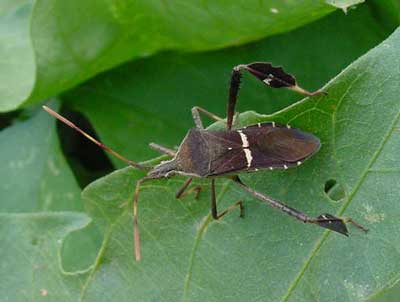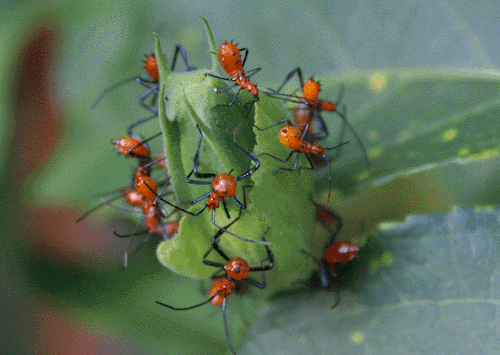Leaf-Footed Bug
by Janet Scheren, Fairfax Master Gardener
 Meet the stink bug’s larger cousin — the leaf-footed bug (Leptoglossus phyllopus). Both have a similar look and emit a foul smelling liquid if disturbed. Stink bugs are usually pale green or brown, while leaf-footed bugs are typically darker brown with a white band running across the wing covers. Both have piercing/sucking mouthparts and feed on not only leaves, stems and blossoms, but also ripe fruit. Damage from stink bugs seems to be more superficial, however. For example, stink bug damage to tomatoes and peppers looks like pinpricks with some corky, white tissue damage. Leaf-footed bugs, in contrast, usually go beyond the surface to create deeper tissue damage. This, in turn, can cause misshaped and discolored fruit.
Meet the stink bug’s larger cousin — the leaf-footed bug (Leptoglossus phyllopus). Both have a similar look and emit a foul smelling liquid if disturbed. Stink bugs are usually pale green or brown, while leaf-footed bugs are typically darker brown with a white band running across the wing covers. Both have piercing/sucking mouthparts and feed on not only leaves, stems and blossoms, but also ripe fruit. Damage from stink bugs seems to be more superficial, however. For example, stink bug damage to tomatoes and peppers looks like pinpricks with some corky, white tissue damage. Leaf-footed bugs, in contrast, usually go beyond the surface to create deeper tissue damage. This, in turn, can cause misshaped and discolored fruit.
The ability to wreak more damage reflects a difference in anatomy as well as in size. Adult stink bugs are about one-half inch in length compared to their larger cousins, which are nearly three-quarters of an inch longer and shield-shaped. Leaf-footed bugs’ piercing-sucking mouthparts extend more than half the length of their narrow bodies. The extent of damage they can inflict depends on maturity of the bug as well. Small nymphs feed shallowly sucking in superficial plant juices. Adult bugs dig deeper into fruit looking for hard seeds. When they find one, such as an almond kernel or juniper berry, they excrete digestive enzymes from their mouths. This liquefies some of the seed so it can be ingested.

Leaf-footed bug nymphs
Stink bug eggs are also distinct from those laid by leaf-footed insects. The former eggs are barrel-shaped, looking something like small pistachio nuts. You’ll find stink bug eggs in clusters of 30 to 100 on the underside of plant leaves that the nymphs feed on. By contrast, leaf-footed bug eggs are golden-brown cylindrical eggs, laid in a straight line. While leaf-footed insects don’t lay as many eggs at a time, they can produce more than 200 eggs each during a two-month period in spring. Leaf-footed bugs, like their smaller cousins, overwinter in protected areas such as woodpiles, under peeling bark or in cracks in trees.
Host Plants
Leaf-footed bugs typically feed on thistles and other weeds in the spring, but the adults migrate from weedy areas into gardens and landscape as better targets — especially ripening fruits — become available. Tomatoes, citrus, pomegranates and melons are prime targets. They also commonly attack beans, cucumbers, peas, peppers and squash.

Leaf-footed bug eggs
Cultural Control
Cultural control methods, a key tactic in integrated pest management (IPM), are practices you can employ before pest problems arise. An important step in reducing the severity of leaf-footed bug infestation is removing weed hosts near gardens and orchards. In some gardens, cover crops are used to enhance soil fertility and draw beneficial insects. Some of these cover crops, however, may also host stink bugs and leaf-footed bug pests. As a result, these need to be carefully monitored for infestation. Cultivated crops grown near an orchard should be closely monitored as well.
Fortunately, leaf-footed bugs are preyed upon by several native parasitic wasps and flies, as well as assassin bugs, spiders and birds. Incorporating flowers into at least 40 percent of your garden and avoiding the use of herbicides or pesticides will help build a squadron of the beneficial insects needed to protect your crops from these and other damaging insects.
Another tactic to keep gardens and orchards free of leaf-footed insects is to install row covers that keep flying adults from entering and laying eggs. Keeping plants healthy, well-watered and appropriately spaced are also important cultural control methods.
If the damage passes an acceptable threshold, try the safest, low-impact techniques first. A good place to start is handpicking. Destroying the eggs, nymphs and adults by hand is highly effective in controlling leaf-footed bugs. Dispose of any captured insects so they do not return to feed again.
Resources
• Eastern Leaf-Footed Bug, James Baker, North Carolina State Extension
• Leaf-Footed Bugs, T. Kuhar, J, Jenrette and H. Doughty, Dept. of Entomology, Virginia Cooperative
Extension
• Stink bugs & Leaffooted Bugs, University of Florida
• Leaffooted Bug, Pests in Gardens and Landscapes, Integrated Pest Management Program, Chuck
Ingels, University of California
• Leaffooted Insect Pests, University of Florida Gardening Solutions